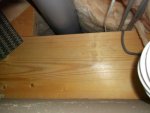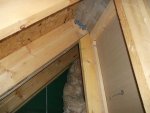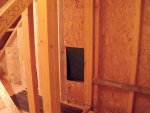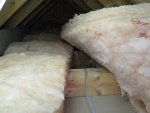Longish story that I'll try and keep short with all the pertinent facts so bear with me. I'm not trying to sell anyone anything but the info I have may save you some money in the long run if you have similar problems within your home. If you don't live in a Springfield house it might be worth your while dropping down to the next to last paragraph and having a read anyway.
Me and my family have lived in a Springfield built Altyre style house on the south side of Elgin for the past 7 years, I am the first owner. The house itself is generally fine however we noticed quite quickly after moving in that the bedroom over the garage was quite a cold room and prone to losing heat fairly quickly in comparison to the rest of the bedrooms. I'm sure I made comment to Springfield about it back in the early days and certainly mentioned it to some of the neighbours but we've all come to believe that it is merely because "... the room is over the garage so it's bound to be cooler than other rooms..." - whether that is/was a Springfield generated belief I'm not sure.
The bedroom is surrounded by 4 'spaces' or 'areas' - because of the design of the house each of these spaces are inaccessable to the average homeowner unless you start making holes in walls and ceilings, they are:
Area 1. The loft space directly above the bedroom.
Area 2. The floor cavity above the garage, under the bedroom.
Area 3. A triangular 'loft space' above the utility room adjacent to the bedroom wall under the velux windows.
Area 4. A triangular 'loft space' at the front of the bedroom, above the garage, beyond the inbuilt wardrobe.
Each of these areas should contain layers/levels of insulation to provide a complete envelope of heat protection around the bedroom as defined and required by the Building Standards at the time - every square inch of the walls, ceiling, coombs and floor should be insulated.
Now then, onto the crux of this post. In November last year I discovered that I had problems with the insulation in Areas 1 and 3.
In Area 1 although there was mineral wool insulation in place it was not laid correctly and there was insufficient to cover the whole surface area. The insulation was across the joists rather than in between (the most basic requirement from donkeys years ago is one layer in between the joists) and did not extend out to the periphery therefore did not meet up with insulation in the walls - a break in the 'insulating envelope' and for all effects and purposes doing virtually nothing to keep heat in the room.
In Area 3 I discovered that the wall underneath the velux windows had absolutely no insulation on it at all - this, in effect, meant that the only thing separating my bedroom from the back garden was 12mm of plasterboard! Also in this space I discovered that, akin to area 1, the insulation in there it had been laid incorrectly: it was not lying directly onto the plasterboard ceiling above the utility room as it should have been and was therefore not providing any insulating protection for the utility room itself.
Eventually the problems were fixed in mid-December (I sorted out Area 1, Springfield sorted out Area 3 - there's more to it than that but I'm keeping the story short remember). Since that point the bedroom has been just as warm and retains heat just as well as the rest of the bedrooms (I would say that the rest of the house has actually benefitted from it too) - I can actually get out of bed in the middle of the night and still be comfortable which is something that was was not possible before thereby dispelling the myth that the room should be cold just because it's over a garage.
When I found the problems in my house I spoke to the residents of the other 24 Altyre style houses on my estate - to this date at least 12 of them have had problems, to a lesser and equal degree as mine, across all 4 areas that I mentioned above. To give them their dues Springfield have been quick to come out, check and make good where necessary; there have only been a few Altyres that have been to the required standard.
However... I confirmed last week, for the owner of a 4 bedroom Moy style house, that he has problems in Area 3 (worse than mine, he has no insulation in there at all) and in Area 2 (only partially insulated). This is a reflection of another 4-bed Moy that I know about across on the Linkwood estate. The problems also have the potential to be present in 3-bed Moys too.
Residents of 3-bed Dunphail style houses have also commented to me that the bedroom over the garage is, in some cases, absolutely freezing. The main difference between Dunphails and Altyres/Moys is that Dunphails do not have a utility room so are missing Area 3. I have yet to gain any proof that any Dunphails actually have problems with insulation as I've been busy and ill over the past week (maybe one of you folk might be the 'lucky' one!).
I am trying to establish (for various reasons that I don't wish to discuss on an open forum) how widespread the problem is - there are quite literally hundreds of these style of houses across Moray and further afield too: I am aware of a limited number of houses in Forres that have had problems, in recently built houses as well as older ones too, and as I mentioned above also on the Elgin Linkwood estate.
There are a few ways in which to check for the presence/absence of insulation the most obvious one being to punch big holes in the walls. But it can be an awful lot less invasive than that. The least invasive is by simply dropping the extractor fan down from the utility room ceiling. There is no need to electrically disconnect it but it might be best to remove the fuse that is part the wall switch. There will be either one screw on the side of the unit or 2 screws under small plastic pop out covers on the face of it that you need to undo to take the cover off. Then remove the 4 screws that actually hold the unit in place. Remove the electrical tape (if there is any) that holds the tubing onto the rear of the fan. Refit it by simply reversing the process.
Look up into the space, you have the beginnings of a problem if you see this:

The insulation should be lying flat on the ceiling.
The next step is to push up through any insulation that is there and try to see whether the wall under the velux windows is insulated: if you see this you definately have problems:

That buff coloured wall on the right should be insulated - 12.5mm through that is the bedroom, plasterboard has no insulating properties whatsoever!
Another quick way to check for the presence of insulation, in any wall, is to pierce the plasterboard with a bradawl or small drill (of about 2.5 to 3mm diameter), remember the plasterboard is only 12.5mm thick unless you're in the garage where it should be 2 layers of plasterboard - be very careful not to drill your way though any pipes or electrical cables! (although where you are likely to be making holes it should be cable/pipe free). Next get a wire coathanger and straighten out the hook. Poke this into the hole you made: you should meet resistance as soon as you've gone through the plasterboard, it should feel like you are poking a duvet or pillow. If there is no resistance at all this would suggest that there is no insulation in place... that's not good! This is a quick check method but the downside of it is that it does not prove whether the insulation is laid correctly nor the depth of the insulation - the loft should have at least 2 layers, one laid within the joists and then another laid over the top but perpendicluar to the lower layer. The holes you make are easily repaired with a blob of plaster and touched up with paint.
The best way to check Area 1 is to make an inspection hole about the size of a sheet of paper from your main loft into the inaccessable space. The wooden partition is only about 6 or 7mm thick, stay quite low and forward of the main loft centerline/apex because the apex of Area 1 is toward the front of the house (look at it from outside, you'll see what I mean):

What you see in there should not look like this:

There should be a layer of insulation between the joists underneath the layer that is laid over the joists. The insulation should also go out to the very edges of the whole ceiling space - this was not the case either.
You may think that having a wee bit of insulation missing or poorly laid doesn't matter, won't make any difference to your pocket, well you may be interested to know couple of things.
A typical 3-bed house that has no insulation in the loft can save up to £175 a year on heating costs by insulating the loft space. The level of savings in comparison to the area of space insulated is not directly proportionate - if you only insulate 95% of the loft space you will not save 95% of the 175 quid; up to 50% of the resultant heat loss will go out though the 5% of loft space that you haven't insulated! So, although you've insulated the vast majority of your loft you may still lose 85 quids worth of heat through that iddy-biddy bit that you didn't cover over. My missing and mislaid insulation accounted for about 30% of the total loft space, I estimate that I have shelled out somewhere in the region of £1200 over and above what I should have paid for my heating costs over the past 7 years
I'm asking you guys and gals to please take notice of this; bring it to the attention of your neighbours or anyone you know who lives in one of the style of houses I've mentioned - this Springfield generated problem has the potential to be affecting a huge amount of households and they haven't been particularly eager to pick up the riens on this despite, to my mind anyway, a moral obligation to do something about it.
If you're reluctant or lacking the tools/skills to check whether you have problems then please get in touch, I have already done it for some of my neighbours. If you want more information please get in touch.
And if you or they discover problems please let me know.
Me and my family have lived in a Springfield built Altyre style house on the south side of Elgin for the past 7 years, I am the first owner. The house itself is generally fine however we noticed quite quickly after moving in that the bedroom over the garage was quite a cold room and prone to losing heat fairly quickly in comparison to the rest of the bedrooms. I'm sure I made comment to Springfield about it back in the early days and certainly mentioned it to some of the neighbours but we've all come to believe that it is merely because "... the room is over the garage so it's bound to be cooler than other rooms..." - whether that is/was a Springfield generated belief I'm not sure.
The bedroom is surrounded by 4 'spaces' or 'areas' - because of the design of the house each of these spaces are inaccessable to the average homeowner unless you start making holes in walls and ceilings, they are:
Area 1. The loft space directly above the bedroom.
Area 2. The floor cavity above the garage, under the bedroom.
Area 3. A triangular 'loft space' above the utility room adjacent to the bedroom wall under the velux windows.
Area 4. A triangular 'loft space' at the front of the bedroom, above the garage, beyond the inbuilt wardrobe.
Each of these areas should contain layers/levels of insulation to provide a complete envelope of heat protection around the bedroom as defined and required by the Building Standards at the time - every square inch of the walls, ceiling, coombs and floor should be insulated.
Now then, onto the crux of this post. In November last year I discovered that I had problems with the insulation in Areas 1 and 3.
In Area 1 although there was mineral wool insulation in place it was not laid correctly and there was insufficient to cover the whole surface area. The insulation was across the joists rather than in between (the most basic requirement from donkeys years ago is one layer in between the joists) and did not extend out to the periphery therefore did not meet up with insulation in the walls - a break in the 'insulating envelope' and for all effects and purposes doing virtually nothing to keep heat in the room.
In Area 3 I discovered that the wall underneath the velux windows had absolutely no insulation on it at all - this, in effect, meant that the only thing separating my bedroom from the back garden was 12mm of plasterboard! Also in this space I discovered that, akin to area 1, the insulation in there it had been laid incorrectly: it was not lying directly onto the plasterboard ceiling above the utility room as it should have been and was therefore not providing any insulating protection for the utility room itself.
Eventually the problems were fixed in mid-December (I sorted out Area 1, Springfield sorted out Area 3 - there's more to it than that but I'm keeping the story short remember). Since that point the bedroom has been just as warm and retains heat just as well as the rest of the bedrooms (I would say that the rest of the house has actually benefitted from it too) - I can actually get out of bed in the middle of the night and still be comfortable which is something that was was not possible before thereby dispelling the myth that the room should be cold just because it's over a garage.
When I found the problems in my house I spoke to the residents of the other 24 Altyre style houses on my estate - to this date at least 12 of them have had problems, to a lesser and equal degree as mine, across all 4 areas that I mentioned above. To give them their dues Springfield have been quick to come out, check and make good where necessary; there have only been a few Altyres that have been to the required standard.
However... I confirmed last week, for the owner of a 4 bedroom Moy style house, that he has problems in Area 3 (worse than mine, he has no insulation in there at all) and in Area 2 (only partially insulated). This is a reflection of another 4-bed Moy that I know about across on the Linkwood estate. The problems also have the potential to be present in 3-bed Moys too.
Residents of 3-bed Dunphail style houses have also commented to me that the bedroom over the garage is, in some cases, absolutely freezing. The main difference between Dunphails and Altyres/Moys is that Dunphails do not have a utility room so are missing Area 3. I have yet to gain any proof that any Dunphails actually have problems with insulation as I've been busy and ill over the past week (maybe one of you folk might be the 'lucky' one!).
I am trying to establish (for various reasons that I don't wish to discuss on an open forum) how widespread the problem is - there are quite literally hundreds of these style of houses across Moray and further afield too: I am aware of a limited number of houses in Forres that have had problems, in recently built houses as well as older ones too, and as I mentioned above also on the Elgin Linkwood estate.
There are a few ways in which to check for the presence/absence of insulation the most obvious one being to punch big holes in the walls. But it can be an awful lot less invasive than that. The least invasive is by simply dropping the extractor fan down from the utility room ceiling. There is no need to electrically disconnect it but it might be best to remove the fuse that is part the wall switch. There will be either one screw on the side of the unit or 2 screws under small plastic pop out covers on the face of it that you need to undo to take the cover off. Then remove the 4 screws that actually hold the unit in place. Remove the electrical tape (if there is any) that holds the tubing onto the rear of the fan. Refit it by simply reversing the process.
Look up into the space, you have the beginnings of a problem if you see this:

The insulation should be lying flat on the ceiling.
The next step is to push up through any insulation that is there and try to see whether the wall under the velux windows is insulated: if you see this you definately have problems:

That buff coloured wall on the right should be insulated - 12.5mm through that is the bedroom, plasterboard has no insulating properties whatsoever!
Another quick way to check for the presence of insulation, in any wall, is to pierce the plasterboard with a bradawl or small drill (of about 2.5 to 3mm diameter), remember the plasterboard is only 12.5mm thick unless you're in the garage where it should be 2 layers of plasterboard - be very careful not to drill your way though any pipes or electrical cables! (although where you are likely to be making holes it should be cable/pipe free). Next get a wire coathanger and straighten out the hook. Poke this into the hole you made: you should meet resistance as soon as you've gone through the plasterboard, it should feel like you are poking a duvet or pillow. If there is no resistance at all this would suggest that there is no insulation in place... that's not good! This is a quick check method but the downside of it is that it does not prove whether the insulation is laid correctly nor the depth of the insulation - the loft should have at least 2 layers, one laid within the joists and then another laid over the top but perpendicluar to the lower layer. The holes you make are easily repaired with a blob of plaster and touched up with paint.
The best way to check Area 1 is to make an inspection hole about the size of a sheet of paper from your main loft into the inaccessable space. The wooden partition is only about 6 or 7mm thick, stay quite low and forward of the main loft centerline/apex because the apex of Area 1 is toward the front of the house (look at it from outside, you'll see what I mean):

What you see in there should not look like this:

There should be a layer of insulation between the joists underneath the layer that is laid over the joists. The insulation should also go out to the very edges of the whole ceiling space - this was not the case either.
You may think that having a wee bit of insulation missing or poorly laid doesn't matter, won't make any difference to your pocket, well you may be interested to know couple of things.
A typical 3-bed house that has no insulation in the loft can save up to £175 a year on heating costs by insulating the loft space. The level of savings in comparison to the area of space insulated is not directly proportionate - if you only insulate 95% of the loft space you will not save 95% of the 175 quid; up to 50% of the resultant heat loss will go out though the 5% of loft space that you haven't insulated! So, although you've insulated the vast majority of your loft you may still lose 85 quids worth of heat through that iddy-biddy bit that you didn't cover over. My missing and mislaid insulation accounted for about 30% of the total loft space, I estimate that I have shelled out somewhere in the region of £1200 over and above what I should have paid for my heating costs over the past 7 years
I'm asking you guys and gals to please take notice of this; bring it to the attention of your neighbours or anyone you know who lives in one of the style of houses I've mentioned - this Springfield generated problem has the potential to be affecting a huge amount of households and they haven't been particularly eager to pick up the riens on this despite, to my mind anyway, a moral obligation to do something about it.
If you're reluctant or lacking the tools/skills to check whether you have problems then please get in touch, I have already done it for some of my neighbours. If you want more information please get in touch.
And if you or they discover problems please let me know.